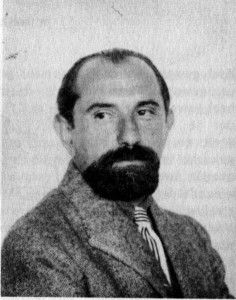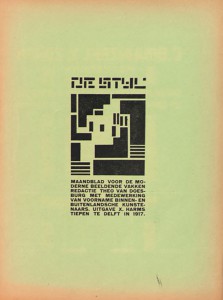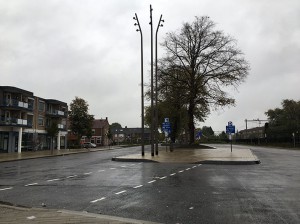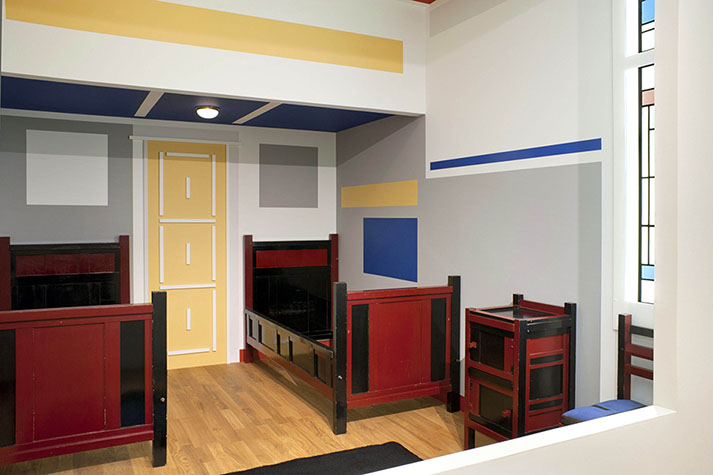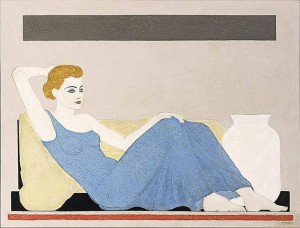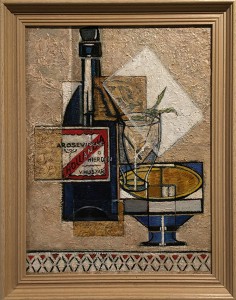Where is Harderwijk? What is Harderwijk? I left the train station in Arnhem, not so ready for a two and a half hour travel to the museum of Harderwijk. There was an exhibition of Vilmos Huszar I wanted to visit, but I just couldn’t think of where Harderwijk is on the map. Is it a city or a village? And why would Vilmos Huszar want to live and work there?
Vilmos Huszar was born in Budapest in 1884. In 1904 he started studying arts in München where he met Anna Egter van Wissekerke. In 1905 they moved to the Hague, the city that would become the center of De Stijl. In the next few years he was travelling a lot and in 1908 he decided to build up a life in the Netherlands and he never went back to his home country. Anna’s parents would not accept a marriage which led to his marriage in 1909 with her best friend Jeanne van Teijlingen with which he also got a child.
After only half an hour in the train we stopped; For your own safety please leave the train at the next station, our apologies. I am very used to these situations with our Dutch train companies so I stayed calm. After waiting half an hour in the dutch cold and rainy weather the next train arrived. Off course this train had some delay which made me miss my next train.
Vilmos Huszar
Vilmos Huszar was experimenting with many different paint styles from 1906 to 1917. A few examples of these styles are divisionism, fauvism, symbolism, futurism, expressionism and synthetism. He referred to this period as the modern period. In 1912 he had his first painting exhibition in the Netherlands. After three years he started meeting artists that would influence the turning point in his art. These artists were Bart van der Leck, Theo van Doesburg, Jan Wils and Chris Beekman. In 1917 the first edition of the magazine of De Stijl was created of which Vilmos Huszar designed the famous logo.
de Stijl magazine
New building materials like reinforced concrete and steel, and the principles of prefabricated construction helped change architecture in the late nineteenth century. Design tended to lag behind technology, however. The architects of De Stijl also designed in the traditional way at first. It was not until later that they began experimenting with new materials, using a new architectural form language, as evidenced by their square, geometric structural volumes, often with rendered walls and flat roofs. Huszar and Rietveld’s space-colour-composition can be regarded as one of the most successful of De Stijl’s interior designs. The radical example of total design can be read both as a plea for the integration of painting, furniture design and architecture and as a manifesto concerning the intimate relationship between colour and space.
Space is experience, spiritual experience. De Stijl sought to deliver a spiritual experience, albeit more universal. The designers of this generation tried to achieve this with huge, monumental spaces that nevertheless had clear architectural boundaries. To them, colour was an effective means of achieving a new spiritual living environment. The idea was to allow the new abstract style of painting to merge completely with architecture.
Eventually I arrived at Harderwijk, still not sure where I was. I went to the bus station and waited a while. After ten minutes I realized none of my busses had arrived yet. The bus station looked abandoned besides the few people in red and black working clothes. I realized they work at Walibi World, a luna park in Holland. A bus showed up, not the bus I had to take. It was going to Walibi World, just like the next three busses. I still didn’t know where Harderwijk was but I knew it was close to Walibi World.
Abandoned bus station
Developments in the industrial production of paint made the vibrant colours used by artists available for architectural interiors, too. The artists of De Stijl made colour ‘separate from the structure’ to ensure that the building was liberated from its conventional enclosed character.
Most art pieces Huszar made in the period he was working at De Stijl have been destroyed after his request. The few art pieces that remain untouched are now situated in big museums around the world.
Finally a lot of busses arrived, most of them going towards France and passing the city center of Harderwijk. Wait what, France is not close to Walibi World right? Or is it? Now I was completely disoriented. I thought my topographical skills were pretty good but after that day I gave up on them. I got in a bus, the woman behind the wheel looked at me, didn’t say a thing. She appeared to me as someone who is tired of living, she was driving like that as well.
In 1920 Vilmos Huszar left De Stijl, it is not totally clear why but some people state it was because of a fight with van Doesburg about the colour scheme Huszar designed. He had enough of the traditional way of painting, he stated it was just a easel painting to fill up museums. We think Huszar’s diversity in his artworks was also a big influence on his leaving of De Stijl. We take this letter he sent to his formal art teacher Bremmer as an example;
“I believe that I am too much of an artist to assimilate what I learned from you in my art works. I write you this so you don’t make any useless efforts. I cannot leave my path but maybe proceed, that means seeing my own way as a tool. I hope to stay in contact.”
Here are a few examples of Huszar’s diversity in artworks besides his paintings, of which one a video of a mechanical dancing figure made in 1920.
Mayors necklace - 1956 / Boys bedroom family Bruynzeel - 1920
When I got to the museum I still had half an hour until closing time. The two and a half hour travel turned out to be four and a half hours. Fortunately this was enough to see the exhibition about Vilmos Huszar and even get a private tour by a guide. The exhibition was divided in three rooms, all showing many different artworks of Vilmos Huszar. The exhibition focused especially on the works he made after he left de Stijl. Some of the artworks exhibited were never shown to a public before. Even though he stopped making artworks in the style of de Stijl, I could find small details in his paintings like a red straight line.
A seated lady - 1932-1933
When walking back to the station I realized Harderwijk was actually a very cozy city (yes it’s a city). It apparently has a beach and it was once a craft city, before 1955 it was a nice fisherman’s town at the open Zuider Zee. The people were very kind and helpful. I would recommend a small visit to Harderwijk to everyone. I suppose Vilmos Huszar lived near Harderwijk because it was a more peaceful place than The Hague, which might have inspired him. When I got in the train to go back to Arnhem I saw an old man waving to the train. Harderwijk is the city where Dutch children visit their grandparents for a few days and then wave each other goodbye at the train station. I was told Harderwijk was the end of the world, a place where you wouldn’t want to be found either dead or alive and that it had a great coffee shop. I believed it but now I know it’s not the end of the world.
Harderwijk view
After Huszar left De Stijl he got many commercial art requests from C. Bruynzeel and Miss Blanche. He made many artworks in different styles, often with small details referring to De Stijl. He would for instance put a red line in a realistic painting. In December 1939 he and his wife Jeanne moved to Hierden, a small village near Harderwijk, because of the war danger. Here he had the chance to go on with making art. During the war he was active in the resistance Migchelsen. In 1945 Jeanne died and not even one month later he got together with his housemaid Anke van der Steen with who he got married in 1953. Jeanne’s parents were very rich, but after her death Huszar was left with only his atelier. Anke, Vilmos and his kid moved to the atelier. They were very poor so Huszar started trading art for basic needs. For instance the still life of a bottle of Hollandia Water to his housemaid.
Still life with bottle of Hollandia water - 1946-1947
In the last few years of his life he went back to painting like he did when he was still in De Stijl. On 8 September 1960 Vilmos Huszar passed away in Harderwijk.
a cooperative research by Athena Potamianos & Justine Wesselo
